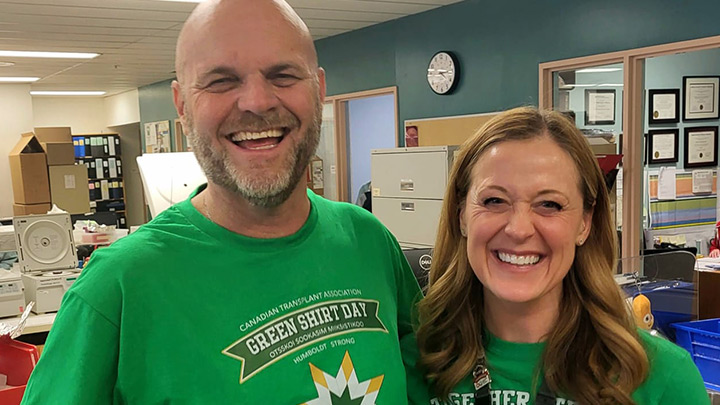
September 9, 2024

Anne Halpin, who received a donor medal for her gift of life to a stranger, poses with her friend, Sean Delaney, who inspired her living donation. Photo courtesy of Sean Delaney.
Story by Su-Ling Goh
EDMONTON – An Edmonton woman who anonymously donated one of her kidneys is grateful for the support she received from her employer, and she’s encouraging more to follow the lead of Alberta Health Services’ (AHS) Living Organ Donor Wage Replacement Policy.
Anne Halpin’s recovery after donation surgery required four weeks away from her work at Alberta Precision Laboratories. During this time, AHS continued to provide her full salary and benefits.
“(Donation surgery) didn’t affect my sick bank, it didn’t affect my vacation bank and I still got paid. That’s amazing,” says Halpin, a clinical laboratory doctoral scientist.
“There are so many barriers to be a living donor… financial shouldn’t be one of them. Having this commitment from Alberta Health Services and Alberta Precision Labs to take (wages) off of my decision-making … it’s an excellent demonstration of their commitment to living donation and transplant.”
The AHS policy grants a paid leave of absence and continuation of benefits for up to 12 consecutive weeks for eligible employees who donate one kidney or a portion of their liver or lung, and up to seven consecutive days for surgical bone marrow donors.
Since 2019, the AHS policy has supported about 20 living donors. “People are giving a tremendous altruistic gift to help someone else by donating (an organ),” says Dr. Scott Klarenbach, an AHS nephrologist and health economist.
“We know donating a kidney leads to improvements in quality and quantity of life compared with dialysis treatment. Kidney transplantation also saves the healthcare system a tremendous amount of money, given the high cost of dialysis of $80,000 to $100,000 per year.”
A kidney transplant can replace — or even prevent — the need for dialysis, a blood-filtering therapy which can require a patient to spend up to 12 hours in a medical unit every week.
Dozens of people in Alberta are waiting for a kidney transplant; the wait time for a kidney from a deceased donor is about three to five years. AHS is one of 36 Canadian members of the American Society of Transplantation’s Living Donor Circle of Excellence, which recognizes employers who offer at least four weeks of paid leave for organ donation. In Canada, the program is implemented by the Kidney Foundation, which also provides support through its Living Organ Donor Expense Reimbursement Program (LODERP).
“Really it should be called the Superhero Program,” says Flavia de la Fuente, Executive Director, Kidney Foundation Northern Alberta & The Territories Branch.
“The criteria is ‘Are you saving the life of an Albertan?’ and if the answer is ‘yes’, (donors) can come from anywhere.”
Living donors undergo rigorous medical testing in hospitals over several months. LODERP, funded by Alberta Health, helps cover expenses including travel (plus a companion), accommodation, meals and parking.
Halpin says her testing process was more convenient for her than for most donors; she works in the University of Alberta Hospital. As an expert in the science behind transplant compatibility testing, she understands the importance of organ and tissue donation, but she never considered living donation until she watched a friend trying to cope while waiting for his kidney transplant.
“Watching him struggle … still working, still attending conferences. He’d go to his (hotel) room and use the ironing board to do his dialysis treatments,” says Halpin.
While she was not a match for her friend (he eventually did find a living donor), she knew she had the power to save a stranger’s life. In the spring of 2022, Halpin anonymously donated her left kidney.
“I spent one night in the hospital, and I went home (with) a pain-management program,” says Halpin. “By the end of that first week, I was easily walking around my neighborhood.”
Halpin started running again three months after surgery. She currently enjoys about 80 per cent of her previous kidney function with just one kidney.
“Physically, I don’t feel any different at all. I’m only happier!” she says.
The 53-year-old will likely never know who her recipient was, but she thinks about them often.
“I hope my little kidney is out there, peeing up a storm for them!” laughs Halpin. “I hope they got some parts of their life back that they’d lost.”
For more information on organ and tissue donation, including living donation, visit www.GiveLifeAlberta.ca.
National Living Donation Week runs Sept. 8 to 14.